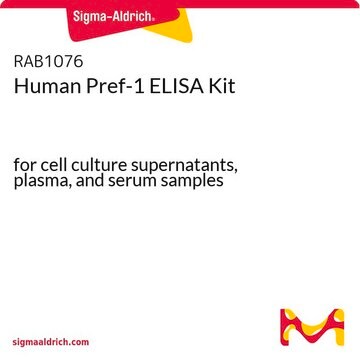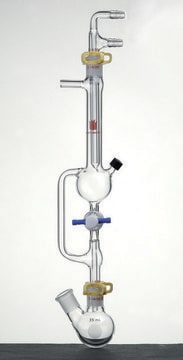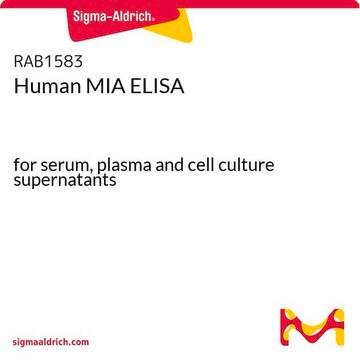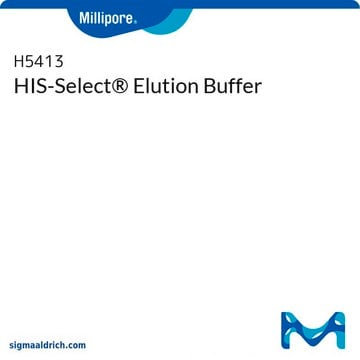Kluczowe dokumenty
11976826001
Roche
MIA ELISA
sufficient for ≤96 tests, Roche, kit of 1 (9 components), suitable for ELISA
Synonim(y):
ELISA
About This Item
Polecane produkty
zastosowanie
sufficient for ≤96 tests
Poziom jakości
opakowanie
kit of 1 (9 components)
producent / nazwa handlowa
Roche
metody
ELISA: suitable
temp. przechowywania
2-8°C
Opis ogólny
Standards: Six standards, ranging from 0 to 50 ng/ml MIA protein, are provided with lot-specific data.
Specyficzność
Immunogen
The antibodies recognize non-overlapping epitopes, which are conformational epitopes (no linear sequence is recognized but rather parts of 3D-conformation). Exact epitopes have not been determined.
Zastosowanie
The MIA ELISA is an ideal application in research studies determining the melanoma inhibitory activity protein in serum and plasma.
The MIA ELISA is specially developed for the quantitative in vitro determination of MIA protein in serum and plasma within streptavidin-coated microplates (MPs). It has a wide applictaion in MIA (melanoma inhibitory activity) ELISA assays.[1]
Opakowanie
Uwaga dotycząca przygotowania
- Anti-MIA-Biotin: Reconstitute the lyophilizate in 0.7 ml double-dist. water for 10 minutes at 15 to 25 °C and mix thoroughly. Do not vortex.
Result: A clear, colorless solution. - Anti-MIA-Peroxidase: Reconstitute the lyophilizate in 0.7 ml double-dist. water for 10 minutes at 15 to 25 °C, and mix thoroughly. Do not vortex.
Result: A clear, slightly yellowish solution. - MIA Standard: Reconstitute the lyophilizate in 0.5 ml double-dist. water for 10 minutes at
15 to 25 °C, and mix thoroughly.Do not vortex.
Result: A clear, colorless solution. Concentration indicated on the label. - MIA Control Serum: Reconstitute the lyophilizate in 0.3 ml double-dist. water for 10 minutes at 15 to 25 °C, and mix thoroughly. Do not vortex.
Result: A Slightly opalescent and yellowish solution. Concentration indicated on the label. - Washing Buffer : Dissolve one tablet in 2 l of double-dist. water.
Result: A clear, colorless solution. - Immunoreagent: For 8 wells (1.8 ml): Add 50 μl reconstituted anti-MIA-Peroxidase (solution 2) to 1.7 ml Incubation Buffer, and mix well. Then add 50 μl of anti-MIA-biotin
(solution 1), and mix thoroughly. Do not vortex.
Result: A clear, colorless solution.
Roche recommends using only double distilled water for the reconstitution of lyophylizates.
Storage conditions (working solution): Anti-MIA-Biotin (vial 1):
6 months at -15 to -25 °C or ≤ -60 °C when aliquoted and shock-frozen
Anti-MIA-Peroxidase (vial 2):
6 months at -15 to -25 °C or ≤ -60 °C when aliquoted and shock-frozen
MIA-Standard (vial 3):
1 day at 2 to 8 °C or 6 months at -15 to -25 °C or ≤ -60 °C when aliquoted and shock-frozen
MIA-Control Serum (vial 4):
1 day at 2 to 8 °C or 6 months at -15 to -25 °C or ≤ -60 °C when aliquoted and shock-frozen
Washing Buffer (vial 6): 1month at 2 to 8 °C
Immunoreagent: 8 hours at 2 to 8 °C
Tylko elementy zestawu
- Anti-MIA-biotin antibody, monoclonal from mouse, lyophilized (clone 2.F7.3B1)
- Anti-MIA-peroxidase antibody, monoclonal from mouse, lyophilized (clone 1.A12.9A1)
- MIA Standard, lyophilized
- MIA Control Serum, MIA in human serum, lyophilized approximately 25 ng/ml
- Incubation Buffer ready-to-use
- Washing Buffer
- ABTS Substrate Solution ready-to-use
- Streptavidin-coated Microplate modules
- Self-adhesive Plate Cover Foils
Hasło ostrzegawcze
Warning
Zwroty wskazujące rodzaj zagrożenia
Zwroty wskazujące środki ostrożności
Klasyfikacja zagrożeń
Aquatic Chronic 3 - Skin Sens. 1
Kod klasy składowania
12 - Non Combustible Liquids
Klasa zagrożenia wodnego (WGK)
WGK 3
Temperatura zapłonu (°F)
does not flash
Temperatura zapłonu (°C)
does not flash
Wybierz jedną z najnowszych wersji:
Masz już ten produkt?
Dokumenty związane z niedawno zakupionymi produktami zostały zamieszczone w Bibliotece dokumentów.
Nasz zespół naukowców ma doświadczenie we wszystkich obszarach badań, w tym w naukach przyrodniczych, materiałoznawstwie, syntezie chemicznej, chromatografii, analityce i wielu innych dziedzinach.
Skontaktuj się z zespołem ds. pomocy technicznej









